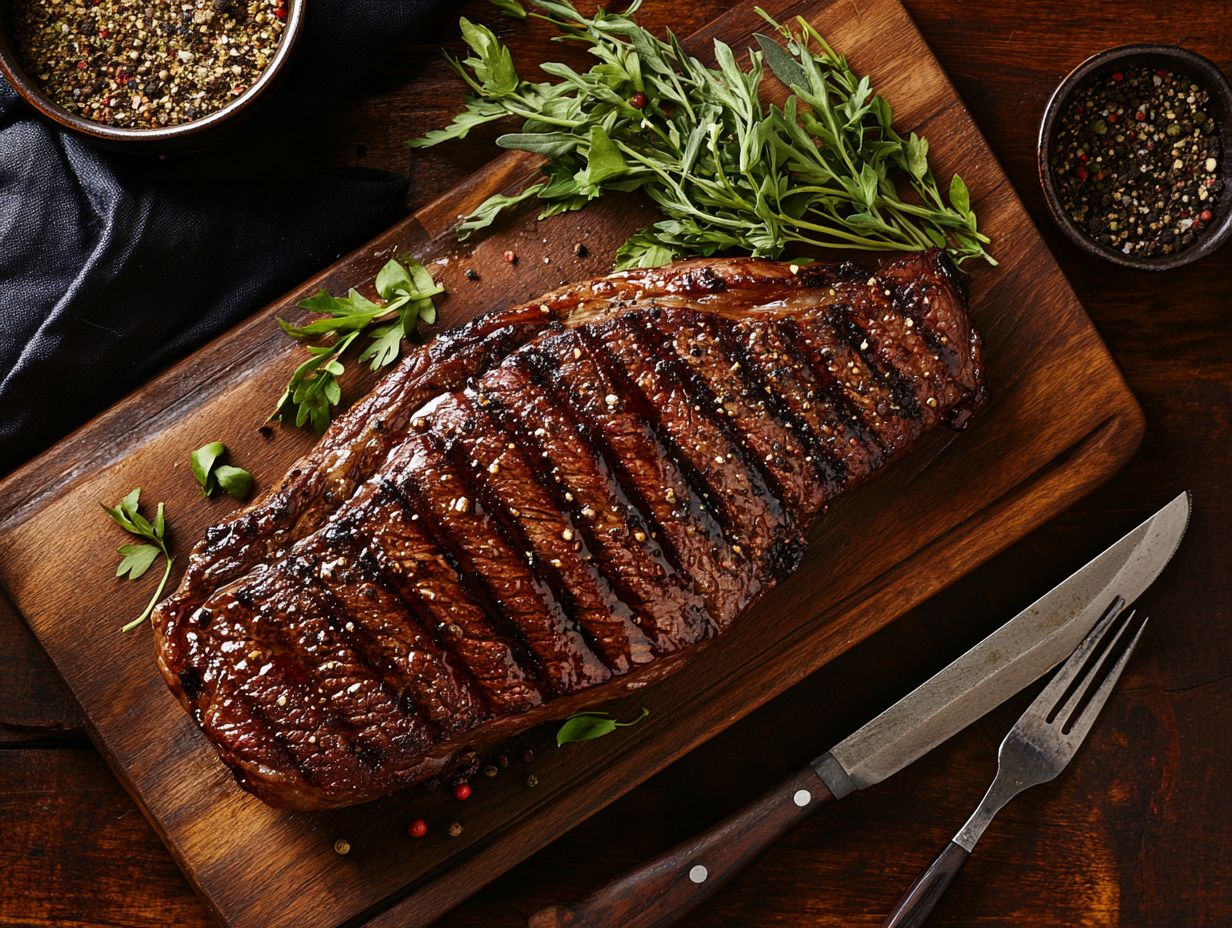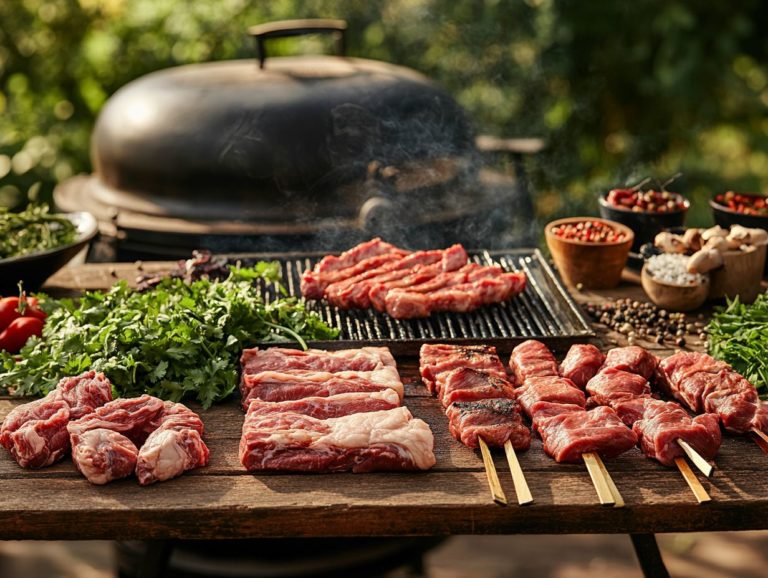The Importance of Resting Meat After Grilling
Resting meat after grilling may appear to be a minor detail, but it is essential for achieving that perfect bite.
When you allow your meat to rest, you give the juices a chance to redistribute. This enhances tenderness and juiciness.
This guide delves into the science of resting meat, an essential cooking technique. It outlines numerous benefits and provides the techniques needed to do it effectively.
You’ll also discover common mistakes to avoid and explore alternative methods to ensure your grilled dishes consistently impress.
Contents
- Key Takeaways:
- Why Resting Meat is Important
- Benefits of Resting Meat
- How to Properly Rest Meat After Grilling
- Common Mistakes to Avoid
- Alternative Resting Methods
- Frequently Asked Questions
- What is the purpose of resting meat after grilling?
- How long should meat rest after being grilled?
- Does the type of meat affect the resting time?
- Can you skip the resting step when grilling meat?
- Should meat be covered or uncovered during the resting process?
- Can you season meat during the resting process?
Key Takeaways:

- Resting meat after grilling allows the juices to redistribute and results in a more tender and juicy final product.
- Proper resting enhances the flavor of the meat, making it more enjoyable to eat.
- Avoid common mistakes like cutting into the meat immediately after grilling. Try alternative resting methods, such as tenting with foil or using a warm oven, for the best results.
Why Resting Meat is Important
Resting meat is an essential step in the cooking process. It allows the fibers to relax and moisture to redistribute, significantly enhancing the flavor and texture of your dishes.
When you take your succulent steak whether it’s a classic ribeye or a pork loin roast off the heat, it retains residual warmth. Checking the internal temperature can prevent overcooking, as the meat will continue to cook.
This vital process ensures that you serve a tender, juicy piece of meat that reflects your culinary expertise.
Understanding the Science Behind Resting
Understanding the science behind resting meat reveals how the muscle fibers relax and allow the flavors to spread throughout the meat. This highlights the importance of carryover cooking, which occurs when the meat continues to cook with residual heat.
As the meat rests, the muscle fibers, which contracted during cooking, start to relax. This relaxation allows the juices, pushed toward the center by the heat, to redistribute evenly throughout the fibers.
Techniques like roasting or grilling trigger this contraction, resulting in a tender texture when you allow the meat to rest properly. As a result, moisture levels rise, enhancing both flavor and texture, making every bite a delight.
Understanding how meat rests helps you cook better and enjoy delicious meals.
Benefits of Resting Meat
Resting meat is the secret to taking your culinary skills to the next level! By allowing each cut be it a juicy steak or a succulent roast to rest, you ensure it reaches its peak potential in both tenderness and flavor.
This simple yet essential step transforms your meal into something truly memorable.
Improved Tenderness and Juiciness

One of the primary benefits of resting meat is the remarkable improvement in tenderness and juiciness. This resting period allows the juices to redistribute throughout the meat, preventing them from escaping when you slice into it.
This technique is particularly vital for larger cuts, like Prime rib must rest to achieve ultimate tenderness, which should rest for a minimum of 15 to 20 minutes after cooking.
During this time, the meat’s fibers relax, resulting in a melt-in-your-mouth texture that you won t soon forget.
On the other hand, smaller cuts, such as Pork chops, can benefit from a shorter resting period of about 5 to 10 minutes, which is essential for minimizing moisture loss.
To retain warmth while ensuring the crust doesn’t get soggy, loosely covering the meat with foil during the resting phase is a smart move. By following these best practices, you can indulge in a beautifully cooked piece of meat that is both tender and juicy.
Enhanced Flavor
The flavor profile of meat truly reaches new heights during the resting period. This essential step allows the natural flavors to develop and intensify, resulting in a richer taste experience especially with quality cuts like steak au poivre.
During this crucial resting phase, the juices that are pushed away from the surface find their way back, redistributing throughout the meat. This means every bite will be incredibly juicy and full of flavor.
Techniques such as searing or smoking create a delightful crust. When combined with the resting process, the complex flavors meld beautifully. This effect is particularly noticeable in larger cuts, like brisket or pork shoulder. Here, the interplay of spices and seasonings deepens significantly over time, delivering a more robust flavor profile.
Ultimately, allowing meats to rest is far from an afterthought; it is an integral step in the cooking process that elevates your dish to extraordinary great taste.
How to Properly Rest Meat After Grilling
Properly resting meat after grilling is essential for achieving optimal taste and texture. This involves a straightforward process:
- Allow the meat to rest,
- Monitor its temperature,
- Utilize tools like loosely covering with aluminum foil to maintain warmth for effective cooling.
By taking these steps, you elevate your culinary experience to new heights.
Step-by-Step Guide
To achieve exceptional results when resting meat, it’s essential to use a meat thermometer to accurately check the internal temperature the temperature inside the meat that affects how well it’s cooked and allow the meat to sit undisturbed for the right amount of time.
This critical step isn’t just about waiting; it enables the juices to redistribute throughout the meat. This enhances both flavor and tenderness while ensuring that the final serving temperature is spot on.
- For example, a turkey, for instance, should rest for at least 30 minutes after roasting for optimal flavor.
- On the other hand, a smaller roast chicken typically benefits from a 15 to 20-minute rest.
Employing a meat thermometer during this process allows you to determine when the meat has reached the desired doneness, effectively preventing overcooking. Covering the meat loosely with aluminum foil can help retain warmth without trapping moisture.
Common Mistakes to Avoid

Avoiding common mistakes when resting meat is crucial for achieving the perfect outcome. Avoiding these common mistakes is essential, as they can lead to substantial moisture loss and a diminished flavor profile in your dishes.
By mastering this essential step, you elevate your culinary creations to new heights.
Factors that Can Affect Resting Time
Various factors can significantly influence the ideal resting time for your meat, including the type of cut, its size, and the ambient temperature in your kitchen or grilling area.
For instance, when preparing larger cuts like prime rib, allowing them to rest for 20 to 30 minutes post-cooking is essential. This resting period enables the juices to redistribute, culminating in a more succulent bite. On the other hand, a smaller roast chicken typically requires only about 10 to 15 minutes of rest before you can begin carving.
It’s crucial to take into account not just the size of the cut, but also its thickness and the cooking method employed. A roast cooked in a hot oven may have different resting needs compared to one that s been slow-cooked, as each method affects how resting elevates the flavor and texture.
Monitoring the internal temperature during this time will further refine your timing, ensuring that every piece is perfectly tender.
Alternative Resting Methods
Exploring alternative resting methods opens the door to surprisingly effective techniques for achieving tender, juicy results. This not only elevates your culinary creations but also simplifies the process for both home cooks and professionals looking to refine their cooking skills.
Try these methods and discover the difference it makes in your meals!
Other Ways to Rest Meat for Optimal Results
Using alternative resting methods, such as placing your meat in a warm oven or utilizing insulated containers, can lead to remarkable results when cooking steak or pork chops.
These techniques help keep the meat at the right temperature while also allowing the juices to move back through the meat. By wrapping it in foil or using a cooler, you preserve that warmth, contributing to a tender and flavorful bite.
For those willing to experiment with these strategies, the rewards can be substantial! Not only does the meat stay hotter for longer after cooking, but the overall enjoyment of the meal is elevated. This allows you to present a beautifully cooked dish that truly honors the art of cooking.
Frequently Asked Questions

What is the purpose of resting meat after grilling?
Resting meat after grilling allows the juices to redistribute evenly throughout the meat, resulting in a more tender and flavorful dish.
How long should meat rest after being grilled?
It is recommended to rest meat for 5-10 minutes after grilling. This allows the juices to redistribute and prevents them from spilling out when the meat is cut.
Does the type of meat affect the resting time?
Yes, the type of meat can affect the resting time. Larger cuts, such as a whole chicken or roast, may require a longer resting time compared to smaller cuts like steaks or burgers.
Can you skip the resting step when grilling meat?
While it is not necessary to rest meat after grilling, skipping this step is not advisable! It is highly recommended for the best flavor and texture. Neglecting this crucial step may result in tougher and drier meat, leading to a common cooking blunder.
Should meat be covered or uncovered during the resting process?
It is best to cover the meat loosely with aluminum foil or a plate during the resting process. This helps retain heat and prevents the meat from cooling down too quickly, thus reducing moisture loss.
Can you season meat during the resting process?
Yes, you can season meat during the resting process. This allows the flavors to penetrate the meat and enhance its internal temperature as it rests, resulting in a more flavorful dish. For instance, seasoning a juicy steak or a salmon roast can enhance the taste even further.






